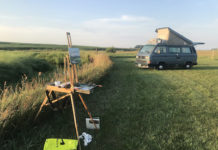
A plein air painting adventure
BY FRANK BRUCKMANN
In the summer of 2021, we took to the road for a month and a half, leaving New Haven, CT, to make our way to the Pacific Northwest.
Preparation: Packing the van to figure out what painting materials were necessary and where to put them was most important. A VW Vanagon camper has many nooks and a few closets to keep art supplies, food, clothing, and other essentials. For art supplies, we used the rear closet, which has access to the back hatch door (which can also be used for shade or rain while painting), enough room for my half-box Julien French easel, a Guerrilla 5” x 7” pochade box, plenty of Centurion oil-primed linen panels, extra tubes of Winsor & Newton paints, palette knives, etc.
As with most things, hindsight is 20/20, and we learned that having a bicycle and camping equipment hanging on the back hatch of the van was an impediment every time there was a great landscape to paint. The medium, turps, and dirty paper towels were kept on top of the van in a plastic container inside the luggage well (the container ended up on the highway once after we forgot to tie it down) to contain the odors as we would be sleeping in the van when it was not convenient to put up a tent.
My wife, Muffy, who watercolors when we travel, decided to record our road trip in journal form. She sketched the daily highlights with lettering and illustrations, adding color with watercolors, inks, and colored pencils, which all fit into a regular backpack.
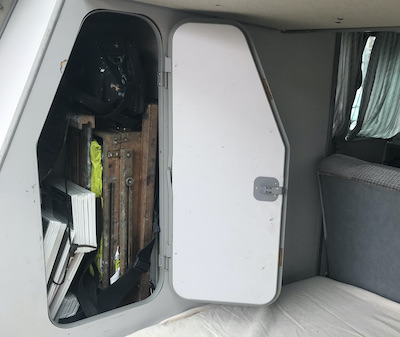
Camping: We camped in locations through Harvest Host (an app that connects self-contained RV’ers to over 2,500 locations), state forests, national parks, and an occasional KOA. Painting at these locations, some quite beautiful, others just a parking lot, gave us an opportunity to paint in areas we probably would not have tried. The basic daily tasks of driving and setting up and breaking down camp, though enjoyable, were very time-consuming and ate into our painting time; ideally this 1 1/2-month, 10,000-mile trip would be more reasonable if spread out over at least three to six months.
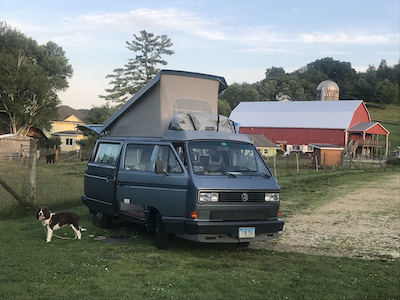
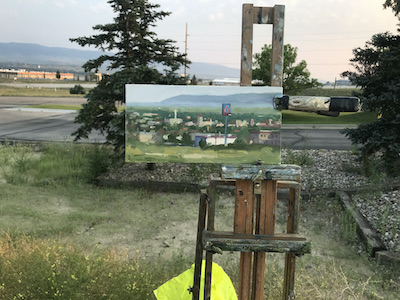
Studio Hacks: My oil paints consisted of 12 to 14 colors that I use both in my studio and while traveling. I have been using Winsor & Newton paints for quite a few years now. I like their consistency and have gotten very used to the paints’ properties — titanium white, alizarin crimson, cadmium red light, cad yellow medium, cad lemon, Naples yellow light, yellow ochre, raw umber, sap green, viridian green, cerulean blue, ultramarine blue, mauve blue shade, and cobalt violet. I try to use a warm and cool for each of the main colors; with this selection I feel I am able to capture most of the landscapes that I encounter.
I also have a good selection of Robert Simmons Signet filbert brushes. They are sturdy and hold up very well. Many times I was not able to wash my brushes properly with soap and water, and the Simmons can handle just a good turp wash and bounce back the next day.
Being that we were confined with space, I painted on a smaller format, which was anywhere from a 5” x 7” up to 12” x 16”, using the front window of my van as my gallery and drying rack. Adding some alkyd white to my titanium and mixing in Liquin to my medium helped to expedite the drying process.
My medium for traveling is five parts turp, one part linseed oil, and another part Liquin. This medium I find to be a bit heavy, but it helps with the drying time. I paint very directly, so the medium was pretty much to loosen some of my thicker paints. At times I also like to add in a touch of medium with my darker colors.
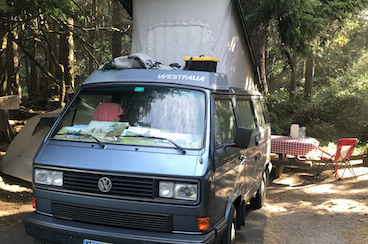
The Journey: Unfortunately, we experienced a bit of car trouble; after repairs and back on the road again, a trucker honked at us in Salt Lake City, alerting us to an issue with one of our tires right before we would have driven out into the Great Salt Desert in the heat of the day. A few hundred miles later, on a major eight-lane freeway during rush hour, our van suddenly screeched and wobbled; one of our brand new tires practically came off, jettisoning its hubcap and four of its six lug bolts. Traveling with a “vintage” vehicle is definitely an adventure that requires patience and (ideally) a gold bullion reserve.
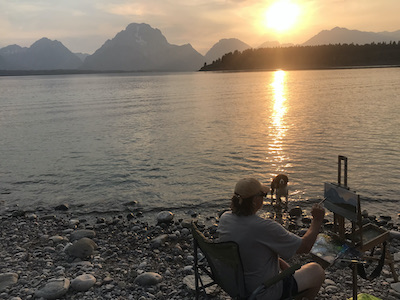
Out West: With the van all patched up, we made a run for Yosemite (side-stepping forest fires throughout the West), then up the coast of California toward our final destination, the Olympic Peninsula. We boondocked in turnouts and scenic views along the Oregon Coast Highway where one can camp overnight. There were so many picturesque places to stop and paint that it deserves at least a full month!
Once I had my box out, I would decide on the format of the canvas. Or if I had to hike to a site, I would bring a few canvases along, a 6” x 12” or 12” x 16”, some combination that would fit together on my easel. I protected wet paintings by putting them back to back while transporting them to the van. I have my easel set up with shoulder straps for carrying. For longer distances, I put my Guerrilla box in my backpack and worked on a 5” x 7” or two, which all fit neatly back into the bag.
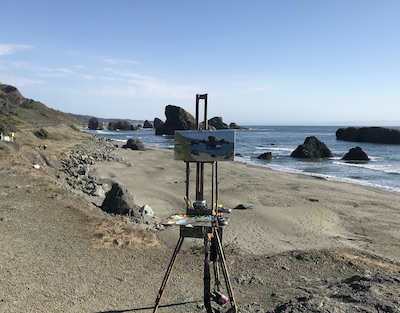
Final Destination: The Olympic Peninsula is an amazingly diverse landscape — giant Sitka spruce, red cedars, western hemlocks, rolling down to long stretches of fine sand, smooth stones, or great protruding rocks that pop out of the ocean like mighty sentinels. Majestic rain forests are just a few miles away from flat and arid scenery where lavender is grown; it’s such an incredible area for a landscape painter.
After a few days of painting on the foggy, chilly coast we moved into the Hoh Rain Forest, which was a bit warmer but had a continuous drizzle. Before turning east, we spent three days exploring Port Townsend and Seattle, places I want to investigate with more time.
With a dashboard stacked with layers of painted evidence of all the splendors of America we’d seen, the final leg of the trip was just highways. It was time to get home, back to one of my favorite places to paint, Monhegan Island, Maine.
Connect with Frank Bruckmann at fbruckmann.com.
Visit EricRhoads.com to find out all the amazing opportunities for artists through Streamline Publishing, including:
– Online art conferences such as Plein Air Live
– New video workshops for artists
– Incredible plein air painting retreats
– Educational and fun art conventions, and much more.
> Subscribe to Plein Air Today, a free newsletter for artists
> Subscribe to PleinAir Magazine so you never miss an issue

